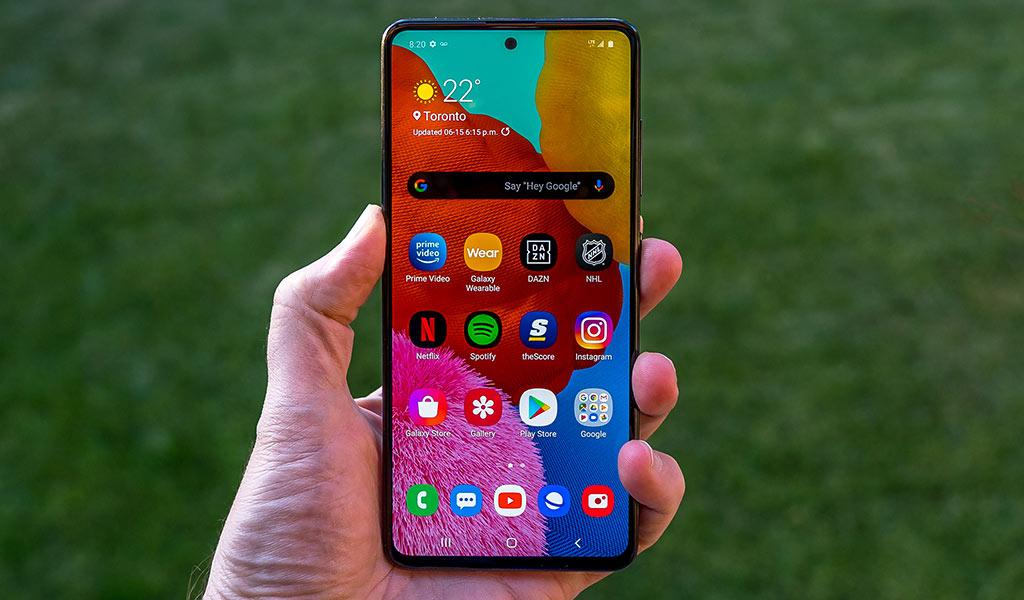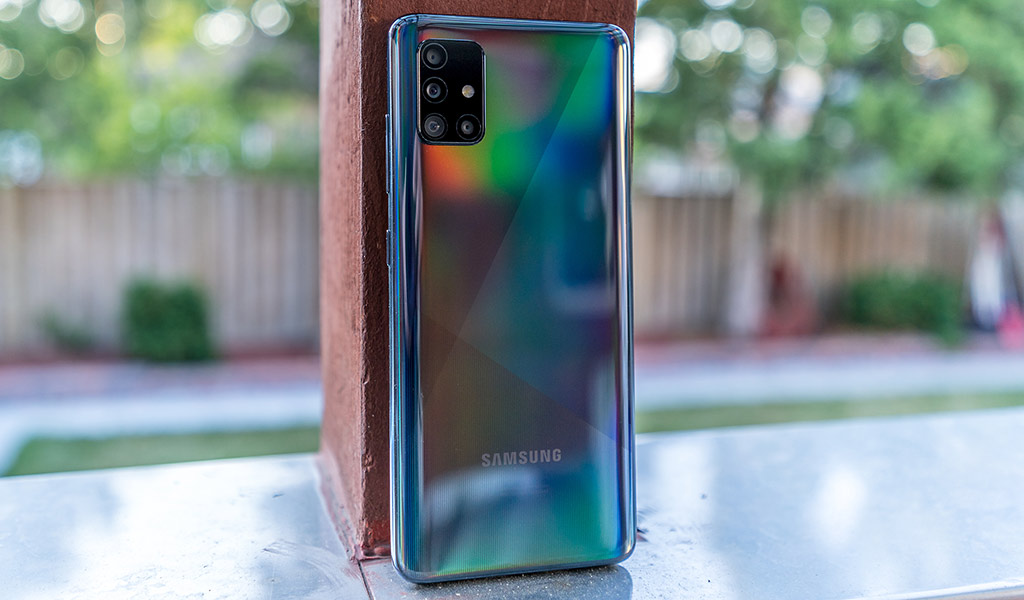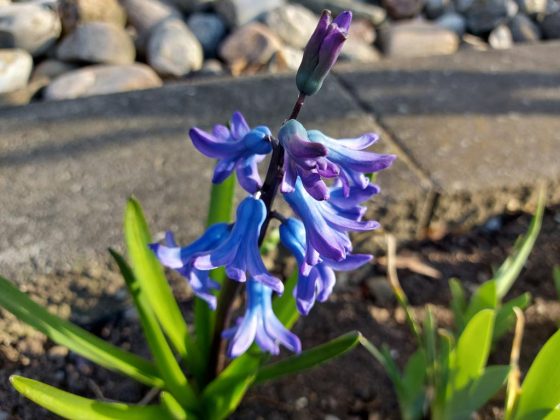
The Samsung Galaxy A51 is the affordable phone that has most features anyone would need without breaking the bank to get a good mobile experience. No matter what, you will sacrifice something when going with a more budget-conscious device. It’s just how it is when you’re talking about a phone that can cost a fraction of the price of a premium handset. The key, then, is the bang for every buck spent on the affordable model. The Galaxy A51 follows its predecessor last year in trying to be everything to someone who doesn’t need everything.
When juxtaposed to its sibling, the Galaxy A71, this phone may give you pause over what move to make. They are similar in some respects, though considerably different in others.
Samsung Galaxy A51 SpecsDisplay: 6.5-inch 2400 x 1080 Super AMOLED display 20:9 aspect ratio with 405 pixels per inch |
Design
Put the Galaxy A51 next to the A71 and the differences aren’t immediately noticeable. Yes, the latter is taller and slightly wider than this phone, but they share the same design philosophy. Despite the display also being slightly different (the A71’s is more vibrant), they look all but the same. The hole-punch front camera is in the same spot. The back panel and camera placement are the same. And the body is made of the same Glasstic material that blends glass and plastic together.
Suffice it to say, the phone doesn’t feel cheap, even though it isn’t using the best materials. Its thin build and lightweight body are augmented by a screen that looks good day or night. With USB-C to charge and a headphone jack to plug in, there’s extra utility available.
For the limited 64GB of storage (of which roughly 49GB is actually free), you always have the microSD slot as an expansion option. The processor and limited RAM, however, won’t make this the fastest or nimblest of phones. Multitasking hits a slog with about six apps open at once, yet remains pretty steady otherwise. Even then, you’re not likely to want to push it that far anyway. Leave it to a task or two and it does just fine.
There is no water-resistance here, making any encounter with liquid potentially lethal for this phone. And though glass isn’t prominent, it’s a pretty fragile device that likely won’t withstand a bad fall. Put a case on it to be safe.
Performance and software
Like I noted in my Galaxy A71 review, Samsung’s consistent improvement with its One UI 2.0 overlay on top of Android is well-suited to an affordable handset, too. It can’t do much about the hardware limitations on board, but also won’t make navigating around difficult or frustrating. It’s a pretty straightforward experience, and a familiar one if you’ve been in the Samsung ecosystem.
Since you have to measure your expectations with any phone of this calibre, I would say the most important thing is that it does the key tasks well. Phone calls, messaging, browsing, social media and music streaming are all fine. Video streaming is okay, too. Mix them together over a full day and you may notice it’s not all as zippy as it could be.
Again, that wasn’t surprising to me. Samsung built this phone with some guardrails, though it will be more than adequate for someone with modest habits. If you’re an avid gamer or love editing photos, this may not be the experience you’re looking for.
That’s partly why it’s easy to compare the Galaxy A51 to the A71. The mostly subtle aesthetic differences are more pronounced when you consider the functional ones. Even if I were to throw in the Galaxy S20, which is considerably more expensive, the gap between these three devices largely centres on what Samsung included to make them better. Sacrificing a better screen, camera and internal components is where the comfort zone is here.

Camera
The camera is a good case in point on that. I shot some of the exact same photos with both the Galaxy A51 and A71, and noticed obvious differences. Even more so if I were to compare to the Galaxy S20. This phone has no optical image stabilization, nor is the image sensor in the same league as what other devices use.
That’s not to say the camera is bad, just that it’s what I thought I would get. Four lenses in a phone like this is unusual, but I’m fairly certain that the one you will trust the most is the main lens. Reason being it has the largest sensor and works with all the different modes. For example, Pro mode still won’t work with any of the other lenses. Night mode will with the ultra-wide, but it gets noisy the darker the scene.
The Macro and Depth lenses are of limited capability because they’re largely dependent on good lighting. The more the lights dim, the harder they have to work. In Macro, focusing can be challenging because slight movements throw off the phone’s autofocus. And if you’re adjusting exposure, you need to be careful not to move.
Despite all that, the phone can take good shots. I just highly recommend that you play around with the exposure slider to reduce the software’s tendency to blast the highlights. Even if the image comes out looking a little dark, you can always fix that when editing later. Bringing in detail from blown-out highlights is near impossible.
There’s plenty to try out with the camera system, but quick snaps should be easy enough if that’s your comfort zone. Same with video, which is decent, and includes filters and Super Steady mode to keep things interesting.

Battery life
When you have a 4000mAh battery and modest specs, you should expect great battery life. The Galaxy A51 didn’t disappoint me there. Except there is one caveat. Streaming video, in particular, will sap the battery faster than using other non-video apps combined. I’m not entirely sure why, but I suspect it’s because of the way the GPU renders video. Either way, it’s not a deal-breaker, since the phone will last a full day on a charge with ease. It’s just that I found the Galaxy A71 to be more efficient.
The phone does come with a 15W charger in the box. There’s no wireless charging support, so plugging in is your only option. It’s fast, and should have you back to full power in an hour or less.
Final thoughts
Your needs and budget will ultimately determine whether you go with this phone or not. If you don’t need the latest and greatest features, and you’re comfortable with what you get here, you likely won’t be disappointed. The good thing is that you have options in case you’re unsure. The Galaxy A71 would be a solid alternative as an upgrade.
The Samsung Galaxy A51 is available now.














Performance and battery life. The best phone I want.
Battery life is awesome. I love the camera capability as my family is located throughout the Provinces – sending a great picture makes a HUGE difference. Love it!
I seriously need a good camera for the grandkids pics, better yet I need the battery life because i constsntly forget to recharge my phone…my phone that doesnt ring.
Faster charging: How wonderful would that be & how wonderdul would a fast refresh rate for me to watch videos on the phone screen.
I think the 108-megapixel standard wide lens camera and the great battery life would make my life a lot easier
Comments are closed.